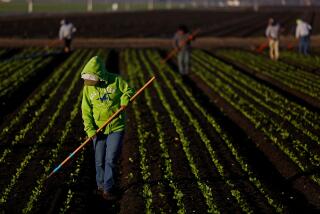‘A Place at the Table’ takes on hunger in the U.S.
- Share via
When people think of hunger, they might picture a starving Third World child. The makers of the new documentary “A Place at the Table” suggest the face of undernourishment can be found much closer to home: Tens of millions of U.S. citizens go to bed hungry every night.
“Americans are for the most part unaware of how vast the problem is,” said Kristi Jacobson. She co-directed the film, which premieres in limited release this weekend, with Lori Silverbush, who added, “You can’t see hunger in America.”
In keeping with the modern wave of activist non-fiction filmmaking, “A Place at the Table” is no impartial documentary — albeit without a Michael Moore-like rabble rouser. Instead, it is a combination primer and jeremiad, an investigation into how a country with so many resources nevertheless has 16% of its population living in households that struggle with hunger and how federal subsidies benefit agribusiness at the expense of the public’s well-being.
While laying out possible solutions, “A Place at the Table” strongly suggests inaction is the worst possible path, particularly because of hunger’s grave health consequences. “The cost to the nation is astronomical,” Jacobson said.
The movie’s genesis was a phone call Silverbush and her husband, the New York-based chef and “A Place at the Table” executive producer Tom Colicchio, received from a middle school principal.
The couple were mentoring a 12-year-old, and the administrator was on the line to report that the student was rummaging through the trash looking for food. She was one of the invisibly hungry: To unsuspecting eyes, she looked well fed but was actually among more than 16 million U.S. children suffering from hunger or “food insecurity,” a condition where the prospects of filling, healthful meals are doubtful.
“She was absolutely the poster child for malnutrition,” Silverbush said of the student, who had suffered from developmental delays and fell asleep in class.
So Silverbush (“On the Outs”) and Jacobson (“American Standoff,” “Toots”) spent months researching the complicated issue, and premiered the film (then titled “Finding North”) at last year’s Sundance Film Festival, where it received mixed to positive reviews and was acquired last summer by Magnolia Pictures.
Even those familiar with hunger in America might be startled by some of their findings, including the scarcity of fresh fruit and vegetables in many locations across the country. These so-called food deserts exist not only in rural locations but also urban settings, where junk food and soda are readily accessible while apples and carrots have left the building.
“No store sells fruit,” short-order cook Ree Harris says in the film about her hometown of Jonestown, Miss. “Chips and ice cream and cakes, they have that there.”
As the film (and a companion book) point out, the U.S. Department of Agriculture found that nearly 14 million Americans lived in such food deserts, where they have low access to supermarkets or large grocery stores.
At the same time, low-income and even working-class families can’t afford to buy fresh produce and quality proteins to feed themselves. If you have only a few dollars to eat, in other words, processed foods will fill you up far cheaper than fruits and vegetables. Federal subsidies, the movie argues, help already profitable large farmers keep ingredient costs down for processed foods, while the smaller farmers who plant produce don’t enjoy similar support.
“We are spending $20 billion a year on agriculture subsidies for the wrong foods,” Marion Nestle, a nutrition professor at New York University, says in the film. “And $20 billion would go a very long way to promoting a healthy, educated population, starting with kids.”
Those facts combine to illustrate “A Place at the Table’s” dramatic linking of obesity to the high cost and scarcity of nutritional food. Hunger and heft, in other words, are symptoms of the same problem.
As the film points out, the price of fruits and vegetables has gone up about as much over the last three decade as the price of processed foods has declined. It’s why a single peach can cost about the same as a Whopper. And that, in turn, is partly driving the nation’s obesity epidemic.
Even if many Americans have little understanding of the nation’s hunger and nutrition problems, Jacobson said there is a way out. “It’s a political condition, and it’s absolutely solvable,” she said. Toward that end, “A Place at the Table’s” release is being augmented by a social action campaign from Participant Media (“An Inconvenient Truth,” “Food, Inc.”), which includes a national action center called Take Your Place to encourage further engagement in the issue.
As the directors explain, the most critical step is raising awareness and then calling on legislators to treat the issue as a matter of national security. Said Jacobson: “We want the people who feel in their gut that this is not right to get more involved and to try to solve the problem. I do believe that film has the potential to change and drive the conversation.”
But the fast-food conglomerates and agribusiness have a ton more lobbying and advertising power than advocates for nutrition and the poor. Case in point: Even though Colicchio’s “Top Chef” has organized cooking challenges around healthful school lunches, the show has run advertising from Dr Pepper, where a 20-ounce serving packs 64 grams of sugar.
“The business of making that show may not be on the same track as the message of the film,” Colicchio said. “But there are things that we do on the show that do promote a healthy lifestyle. And Whole Foods is one of our sponsors.”
PHOTOS AND MORE
VIDEO: The making of ‘Argo,’ ‘Les Miz’ and more
ENVELOPE: The latest awards buzz
PHOTOS: NC-17 movies: Ratings explained
More to Read
Only good movies
Get the Indie Focus newsletter, Mark Olsen's weekly guide to the world of cinema.
You may occasionally receive promotional content from the Los Angeles Times.











